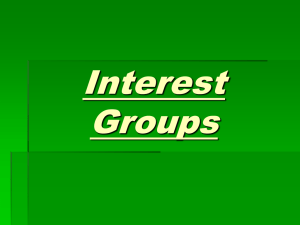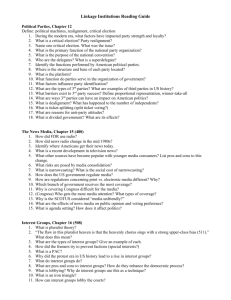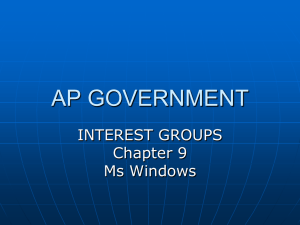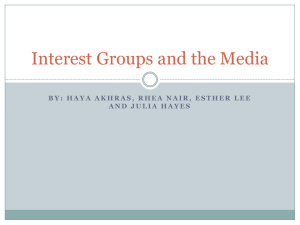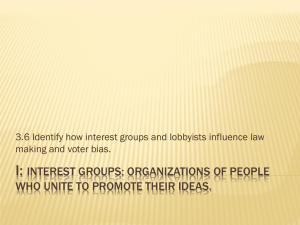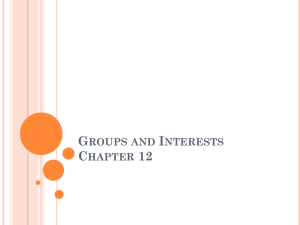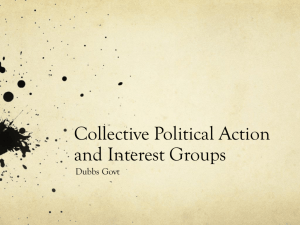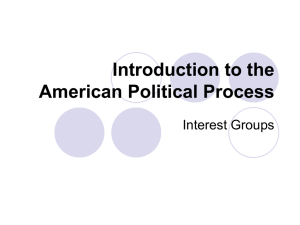Interest Groups
advertisement
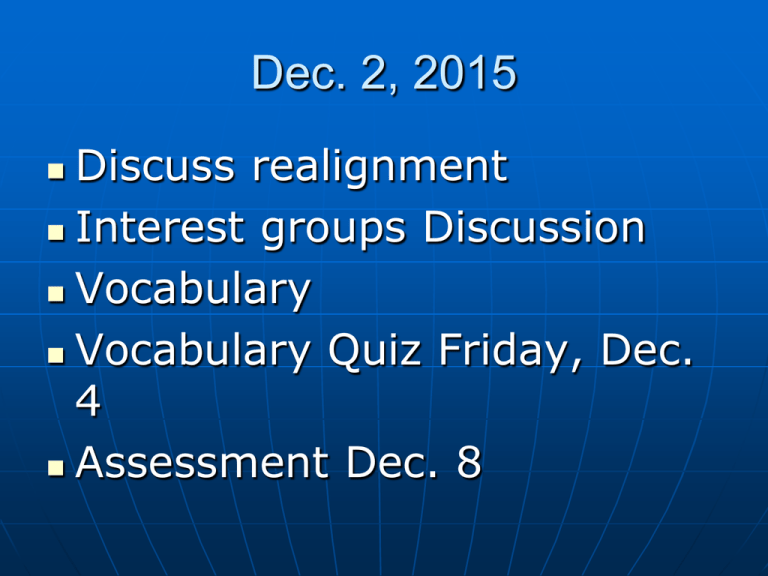
Dec. 2, 2015 Discuss realignment Interest groups Discussion Vocabulary Vocabulary Quiz Friday, Dec. 4 Assessment Dec. 8 Realignment A dramatic change in the political system that lasts for decades. Realignment Criteria A critical presidential election in which the electorate changes its voting pattern The electorate is torn on a major issue A political party weak enough for a new party to take control or to reflect a significant change in voter characteristics GOVERNMENT INTEREST GROUPS What is an Interest Group? A group of individuals with common interests and seek to influence the government in some way (“Special Interests”) James Madison called them “factions” Did not like them, but felt they were inevitable to society. How does an Interest Group begin? USUALLY begins as a social movement Examples-abolitionists, civil rights, women’s rights, animal rights, etc. Political Parties –vs- Interest Groups | Political Parties • Nominate Candidates • Elections • Controlling Govt. Interest Groups • Influence policies of govt. • Interested in the ”what” of govt. Both are made up of people who unite for some political purpose • Interested in the “who” of govt. • Accountable to the public • Focus on voters and their candidate • Private Organizations • Focus on issues and what directly affects the interest of their members Types of Interest Groups Economic Ideological/Single Issue Public Interest Foreign Policy Government Itself Not all interest groups are mutually exclusive-some overlap into different types Group work Economic Interest Groups Businesses - large corporations to individual owners McD’s, Coke, AT&T, Microsoft, Amazon Trade & Other Associationsbusinesses with similar interest join together. Chambers of Commerce Labor - workers associations or unions •Represent workers’ interests •Membership is low in the US compared to other industrialized countries •Examples-- Fraternal Order of Police, International Longshore, etc… Professional AssociationsProfessionals form of a union. •Can be national or state or local •American Bar Association, National Education Association, AMA IDEOLOGICAL/SINGLE ISSUE Ideological – set pattern of beliefs (conservative, liberal, libertarian…) ACLU, Christian Coalition, Moral Majority Single Issue (more specific) Very adamant about position (right or left) and unwilling to compromise NRA, Pro-Life, Pro-Choice PUBLIC Interest Groups “for the public good” Focus on public policies that benefit all or most Americans FOREIGN POLICY Interest Groups To promote or oppose certain foreign policies Council on Foreign Relations, American-Israel Political Action Committee, National Association of Arab Americans GOVERNMENT Interest Groups Government employees want to be organized and heard National Governors Association, National Education Association You will be able to … Describe the role of interest groups in influencing public policy Compare and Contrast political parties and interest groups Describe the different types of interest groups Explain how interest groups work How do Interest Groups Work? Interest Groups have three goals Supply the public with information an organization thinks the people need Try to build a positive image for a group To promote a particular public policy Propaganda Is a technique of persuasion aimed at influencing individual or group behavior Interest Groups use propaganda to create the public attitude they want Mass media encouraged the use of propaganda What do Lobbyists do? Use a variety of techniques to try to persuade legislators to share an interest in a group’s points of view. Provide two types of information: Political (who supports what) and Substantive (impact of proposed legislation) What are Lobbyists? Employees of an association that try to influence policy decisions and positions in the government Revolving Door-moving from a government job to a lobbying job (common-good contacts already made) A former gov’t worker cannot directly lobby their former agency or office Revolving Doors produce networks of people involved with certain issues. These networks are called IRON TRIANGLES. •Mutually supporting relationships among interest groups, congressional committees, and gov’t agencies What are PACs? Political Action Committee is the political part of an interest group Can legally raise money for candidates or political parties from members, stockholders, or employees (of interest group) The Growth of PACs 1970s number of PACs increased About 4,000 today PAC LIMITS Federal Elections Campaign Act (1971) limits PACs to $5000 per election or $10,000 per election cycle (primary and general election) “Bundling” helps PACs get around the limits SOFT MONEY-PACs have no limits to contributions made to a political party for party-building purposes
